| Photojournal
- 10 October 2004
The
chipping plant
|
The 9th of October
was a Saturday, and I slept in, had my customary long brunch in
the afternoon, and then decided there wasn't enough time to do
any serious shooting. Brunch often runs from 1 to 3:30 or so.
So my first time out
in the field on the weekend was the 10th. I had arranged to meet
my new pal Tim at Iona Beach around 9. I had met Tim at brunch
a few weeks before, and he's the one that inspired me to go photograph
the Mute Swans.
Well, we met at the
appointed hour and went through the birder's gate over to the
inner ponds. The day was a bit overcast, but there was still plenty
of light.
Our day started as
Iona days often do, with a Savannah Sparrow beside the dirt path..
|
|
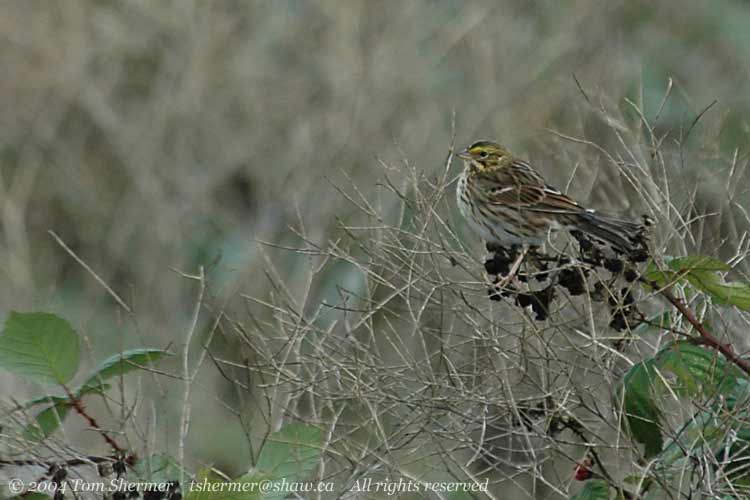 |
|
Reaching the southwest
pond, we saw that there weren't too many birds around. Those birds
that were there were regulars--like this Pectoral Sandpiper.
|
|
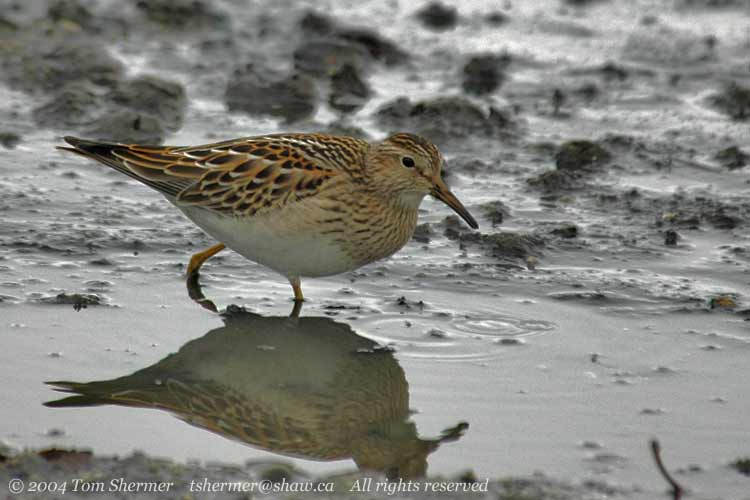 |
|
For some reason, perhaps
one to do with sewage treatment, the pond had a lot of little
bubbles across much of its surface. As the sun played peek-a-boo
from behind the clouds, the bubbles glinted and gave the pond
surface a very shiny appearance.
Out on the pond, there
was a pair of Gadwall; this photo was taken without the bright
sun but you can still see how shiny the bubbles were.
|
|
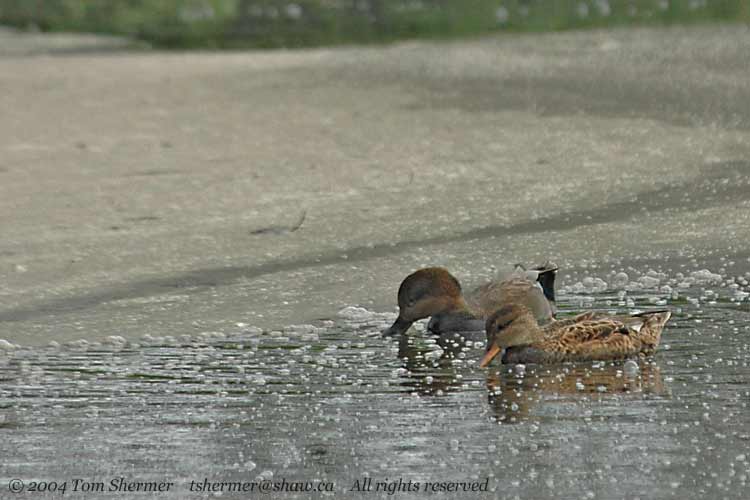 |
|
I think it's just the
camera angle and pose, but the male Gadwall (the one in the back)
looks like he's got a huge mutant head on him to me. His head
looks way bigger than the female's.
With nothing really doing
at the inner ponds, we headed back out the gate and walked along
the road towards the beach a ways. There we found this very drippy
mushroom. We each took a whack o' pictures of it. Currently I use
a picture of this mushroom as my background picture on my desktop. |
|
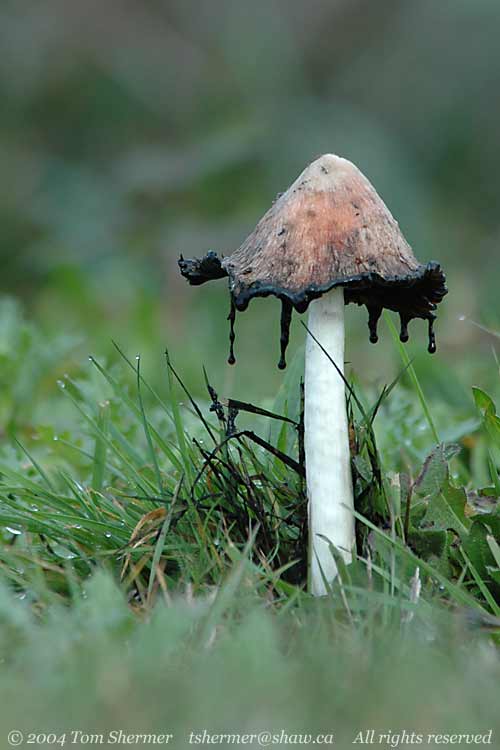 |
|
It turns out that this
is a very interesting mushroom species. I spent a few hours with
guide books and internet sites trying to figure out what it was,
but nothing seemed to fit. Finally, I did two things: first, I
sent the picture to the Vancouver Mycological Society, and second,
I moved on to identify another type of mushroom, which I had taken
photos of right after this one.
Well, the second type
of mushroom is the Shaggy Mane, or, if you're big on dead languages,
Coprinus comatus. Here's a photo of two of them
all snuggled up together.
|
|
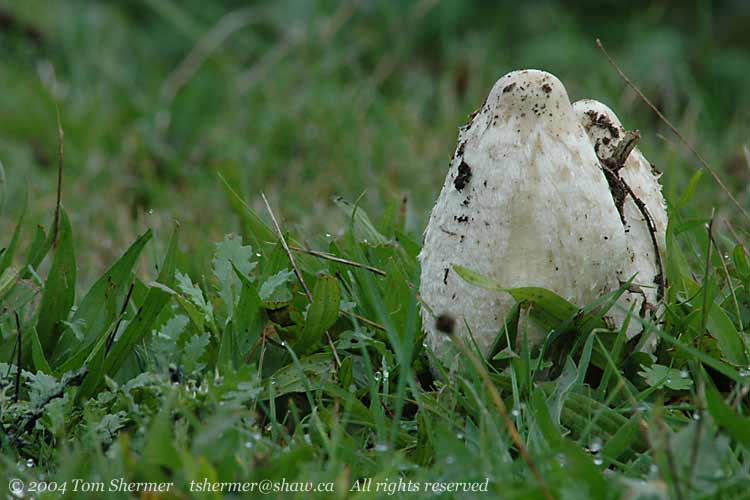 |
|
Now, in reading the
description of the Shaggy Mane, I found that the bulbous shape
is just the cap of the mushroom; it's hollow inside with a stalk.
The underside of the cap has gills, which are ridges that go radially
from the stalk to the edge of the cap. (Many mushrooms are gilled.)
And furthermore, the guide book says that the white cap turns
inky from liquefying gills.
In other words, the
cap on this mushroom slowly turns to black goo. And since my first
mushroom sure seemed to be dripping with black goo, I now suspected
it was a Shaggy Mane, too. The only problem is the salmon-peach
color on it wasn't mentioned in my book anywhere.
Well, I got a nice
response from the mushroom club president, a fellow named Kent,
who confirmed my belated hunch that my first mushroom was a Shaggy
Mane. He says that the black goo contains the mushroom's spores,
and that it likely gets stuck on animals or plant matter and thereby
dispersed to other locations.
So the Shaggy Mane's
life cycle is to grow a mushroom with a big, all-encompassing
cap, then to dissolve the cap to send spores on their way. Presumably
it then shrivels up and dies...I also found these mushrooms nearby,
and I think they are the fully-eroded Shaggy Mane.
|
|
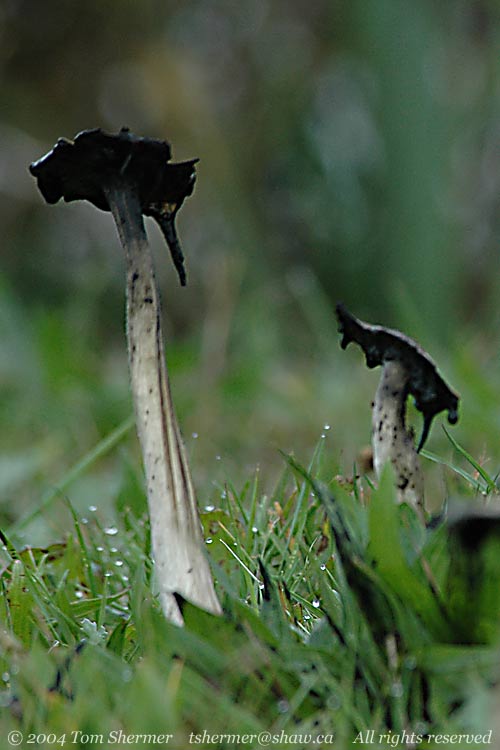 |
|
When fresh (like the
second photo), the Shaggy Mane is edible. My guide book says they're
a good substitute for asparagus, and the mushroom guy Kent says
they're very tasty.
So that's neat. I didn't
know that there were mushrooms that intentionally turned themselves
to goo. (Yes, I know I'm going out on a philosophical limb here
by assigning intent to a mushroom.)
Getting back on the
10th of October, Tim and I decided to head up to the north side
of Iona Beach Park. Up that way there's a chipping plant, a place
where logs and wood are turned into wood chips. It being Sunday,
or for whatever reason, the plant wasn't operating, and Tim and
I headed in to see if there were any good photos lurking inside.
The chipping plant
consists of many big piles of wood, logs, and wood chips, with
heavy machinery and parts sprinkled in. Since I like old, rusty,
industrial stuff, and almost nothing there seemed new, it was
a treat. First up was some of the relatively new stuff, like this
log trailer.
|
|
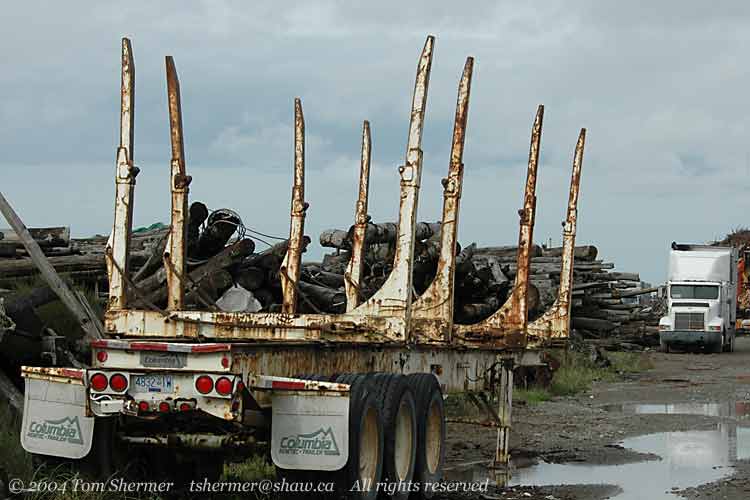 |
| By the side
of the main road, there was a piece of equipment (a frontloader?),
listing in the mud. I think it had a flat or two, too. |
|
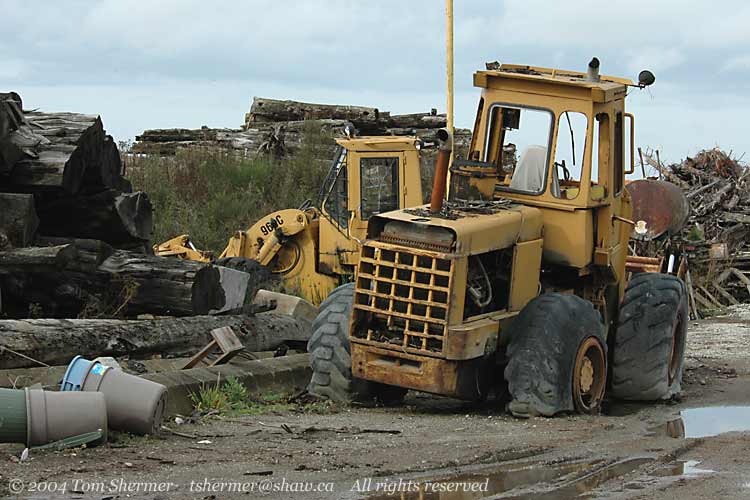 |
|
We poked around some
side passages, which were a bit like cul-de-sacs, and saw various
pieces of machinery. One of my favorites was a big green steamshovel
with hydraulics all over its outside. (I like complicated hydraulic
stuff.) Here's a shot of the green guy; I've stylized this photo
quite a bit in Photoshop (for instance, although you might not
have guessed it, the steamshovel wasn't softly glowing in real
life).
|
|
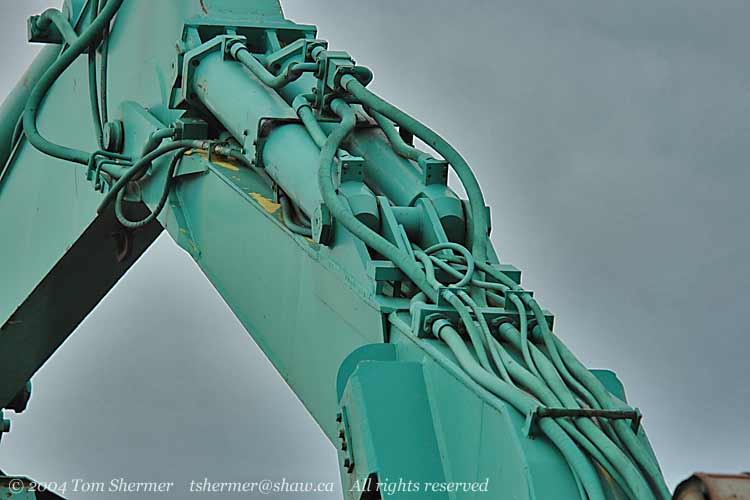 |
|
I was getting the feeling
that they used these big machines here, but when one broke down,
they would just leave it where it broke down and work around it.
The frontloader had that appearance, as did the next bit of machinery,
a Hyster. I'm guessing that Hyster is a type of forklift.
|
|
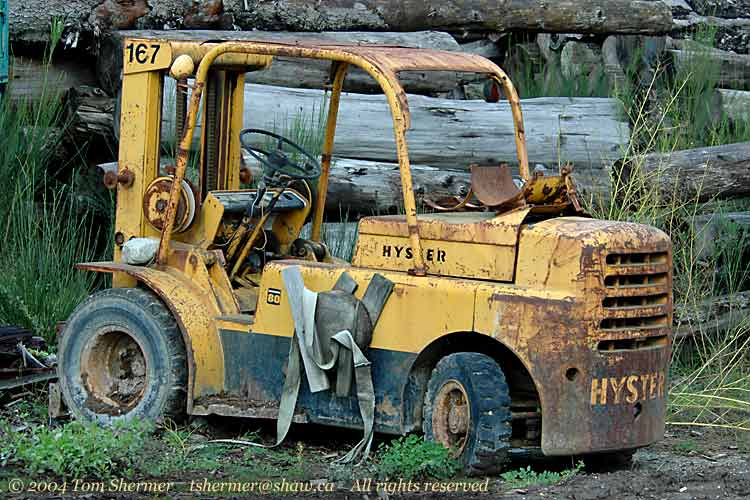 |
|
My companion Tim was
a mining engineer and he betrayed some familiarity with Hysters.
Here we have a beautifully
rusted heelboom grapple, which is used for picking up logs. Or
maybe I should say, which was used for picking up logs.
I liked the contrast of the shiny hydraulics with the rust on
the grapple, but none of my closer-in photos of it were interesting
enough. Maybe I'll get another chance to photograph it someday.
|
|
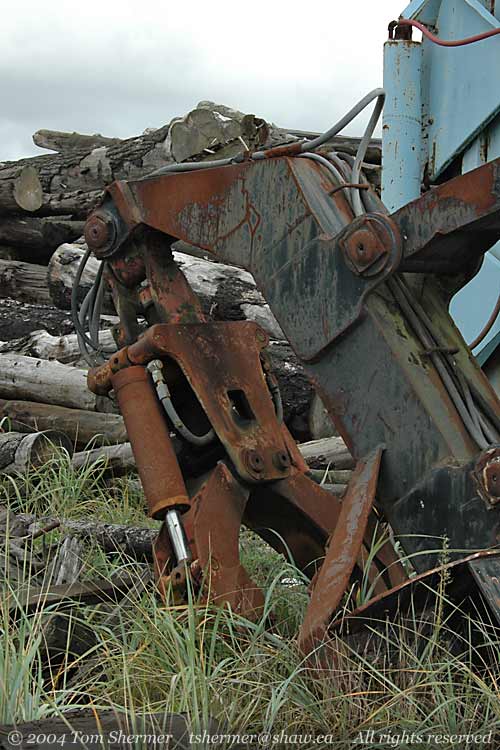 |
|
On the other side of
the road, there was a bunch of old crawler track.
|
|
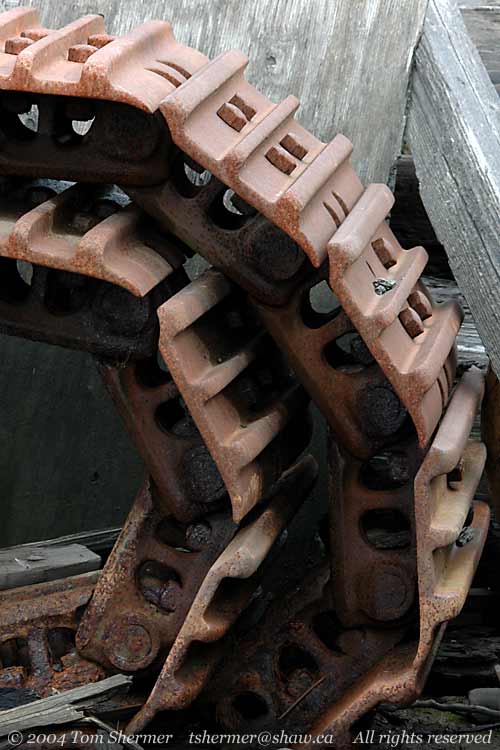 |
|
We continued west along
the road and found the following device. Tim told me what it was,
or a surmise of what it was, but I can't remember what he said.
I think it's a hopper of some sort.
|
|
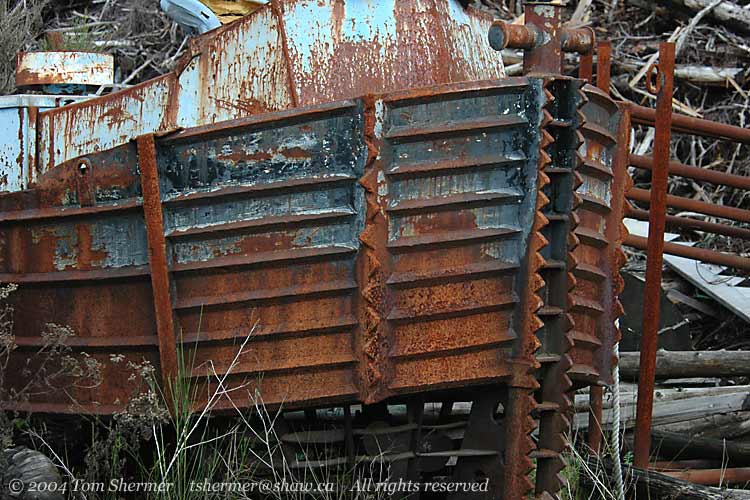 |
|
We had seen big piles
of logs, and big piles of wood chips. Back in this area, we found
a big pile of wood strips. Here is part of it, with a lovely broken
blue pallet in front.
|
|
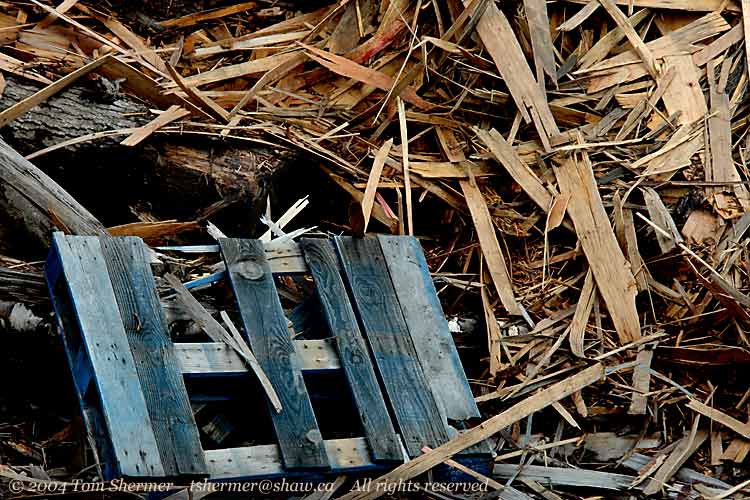 |
| Looking
north from the wood strips, there was a pile of wood chips that
had had the middle excavated out of it. Not surprisingly, there
was a barge full of wood chips behind it. |
|
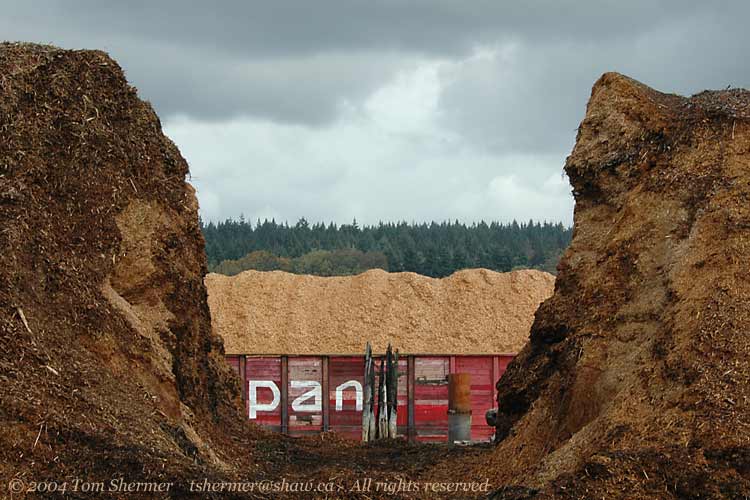 |
|
It was getting late,
and I knew we had to go soon. I found two more subjects to shoot.
The first was a metal claw on a weathered log pile...another interesting
contrast.
|
|
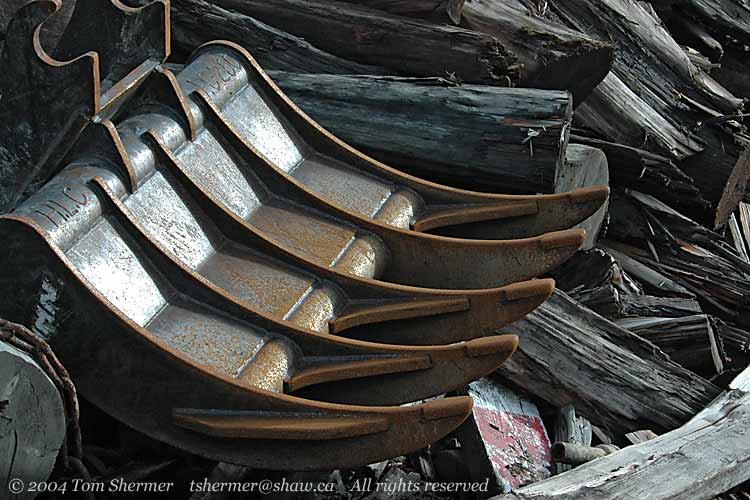 |
|
And my final subject
was a pile of wood chips that towered like a mountain range.
|
|
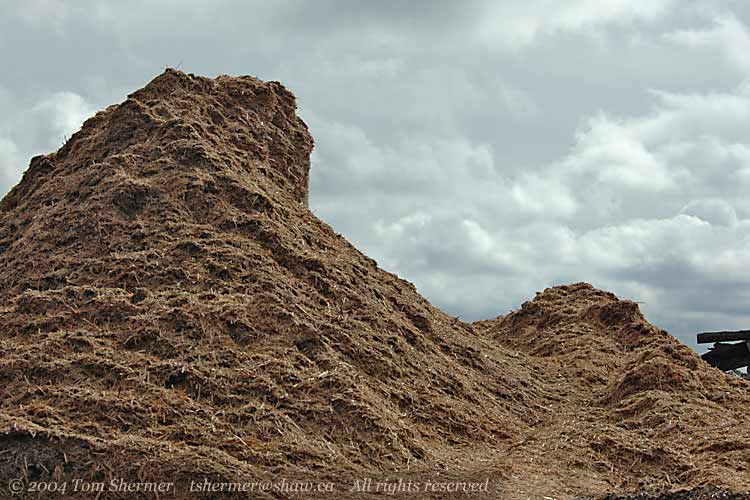 |
|
Time had indeed run
short and we made our way back to our cars with no more photographic
excursions. The chipping plant had given up some good photos,
but I'm sure it's got plenty more...different light, like a sunny
day, would yield a whole different set of interesting views. And
beyond the chipping plant is the north jetty of Iona, which I've
never explored. If it's anything like the south jetty, I'll have
plenty to entertain me for many future trips to Iona.
Happily digging through
the wood chips,
Tom
|
|
|